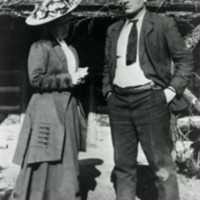Ranchers and Ranching Life
One of the most well-known ranchers is Charlie Bair. Bair found his fame and fortune as a sheep rancher and businessman, and quickly grew to become one of the most well-known, and richest, people in Montana. Courtesy of the Billings Public Library via Big Sky Country Digital Network.
For ranchers, it was crucial to find a good, reliable water source to build a ranch around. A rancher who claimed a 360 acre homestead with access to water could then use the open range to graze thousands of acres. Ranchers began dividing the Montana Territory into grazing districts, which were managed by ranchers who unofficially claimed a grazing area or "range." Range boundaries and brand descriptions would be published in the nearest local newspapers.
The daily work of the cattle ranch was done by cowboys who tended to the cattle. The work of cowboying entailed hard physical labor and required an adventurous spirit. The profession attracted young men—many began as teenagers—who enjoyed working together. Few older men had the stamina to work in the bitter cold of winter and blazing heat of the summer months.
Sheepherders lived in a covered wagons and moved camp and the herd from place to place as the grass was eaten. Sheepherders spent months at a time alone on the range. They travelled by horse, but also put in many miles by foot to keep track of their flocks and protect them from wild animals and disease.
Life on the ranch was often hard. Montana's vast open ranges were ideal for cattle grazing, but this meant that neighbors and cities were few and far between, making family central to the success of the ranch. The frontier women maintained the house, cooked, and often acted as doctors and accountants for the ranch. The ranching women of Montana were an irreplaceable part of the cattle industry.






